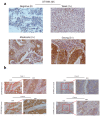The Impact of DTYMK as a Prognostic Marker in Colorectal Cancer
- PMID: 36895992
- PMCID: PMC9990730
- DOI: 10.14740/wjon1571
The Impact of DTYMK as a Prognostic Marker in Colorectal Cancer
Abstract
Background: Overexpression of deoxythymidylate kinase (DTYMK) has been associated with more aggressiveness and pathological behaviors in hepatocellular carcinoma (HCC) and non-small cell lung cancer (NSCLC). However, the expression of DTYMK and its prognostic significance in colorectal cancer (CRC) patients are yet unknown. The goal of this study was to investigate the DTYMK immunohistochemistry reactivity in CRC tissues and to see how it correlated with various histological and clinical features as well as survival.
Methods: Several bioinformatics databases and two tissue microarrays (TMAs) of 227 cases were used in this study. Immunohistochemistry assay was used to study the protein expression of DTYMK.
Results: Based on the GEPIA, UALCAN, and Oncomine databases, DTYMK expression has increased in tumor tissues at both RNA and protein levels in colorectal adenocarcinoma (COAD) compared to normal tissues. A high DTYMK H-score was found in 122/227 (53%) of the cases, whereas a low DTYMK H-score was found in 105/227. The age at diagnosis (P = 0.036), stage of the disease (P = 0.038), and site of origin (P = 0.032) were all linked to a high DTYMK H-score. Patients with high level of DTYMK had bad overall survival. Interestingly, high DTYMK protein level was associated with PSM2 (P = 0.002) and MSH2 (P = 0.003), but not with MLH2 or MSH6.
Conclusion: This is the first study to cover the expression and prognostic significance of DTYMK in CRC. DTYMK was upregulated in CRC and could be considered as a prognostic biomarker.
Keywords: Colorectal cancer; DTYMK; H-score; Prognosis.
Copyright 2023, Aloliqi et al.
Conflict of interest statement
The authors have nothing to disclose related to this work.
Figures



References
LinkOut - more resources
Full Text Sources
Research Materials
Miscellaneous
